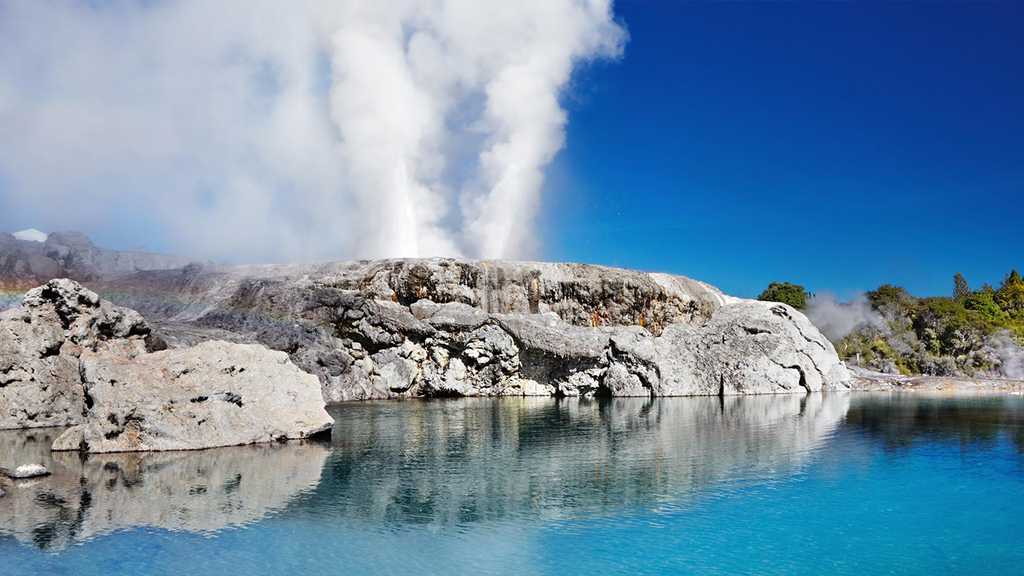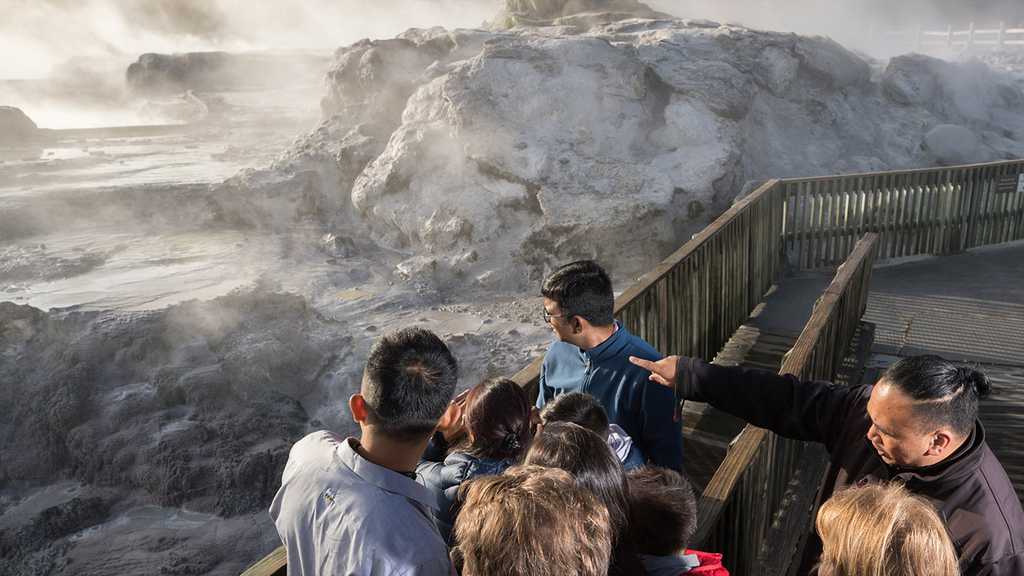New Zealand Geothermal Wonders
Towering mountain ranges, lakes formed from giant craters and fertile hills and valleys – New Zealand’s landscape offers a wealth of extremes. This is because the country sits on an active fault line, resulting in a lot of volcanic activity. Wherever water is heated under the earth, it will find a way to escape, often with spectacular results!
The Taupo Volcanic Zone covers the area around Rotorua, Lake Taupo and the Bay of Plenty and is a hotbed of geothermal activity. Only Yellowstone National Park in the United States is more active! There are many other places around New Zealand where you can experience volcanic or geothermal activity, but in Rotorua you will find the most concentrated area. This is one of many reasons why Rotorua is a top destination for visitors to New Zealand.
When you visit the Rotorua region you can see geothermal activity like geysers, boiling mud pools, mineral hot springs and other fascinating sights. Read on to find out more about New Zealand’s geothermal wonders.
Types of Geothermal Activity in Rotorua
Geysers occur when hot water under the ground is forced through a narrow opening. Pressure builds up and the result is a series of eruptions of very hot water and steam. Many geysers in the Taupo Volcanic Field are known for erupting at regular intervals. The largest and most famous geyser in Rotorua is the Pohutu Geyser in Whakarewarewa Thermal Valley. The Pohutu Geyser erupts up to 20 times a day and shoots steam as high as 30 metres (nearly 100 feet) into the air.
Mud pools form where steam and gas rise from underground into rainwater ponds. The acidic gas transforms rocks on the surface into a clay, which mixes with the heated pond water into mud. The steam heats the mud and makes it bubble. Some mud pools can reach boiling temperatures, so be careful around them and take note of warning signs and fencing.
Fumaroles are steam vents through which steam and gases escape from deep under the earth.
Sinter terraces are created from the mineral deposits left by overflowing hot springs. Over time the minerals build up in layers in beautiful and fragile formations, often coloured by different micro-organisms.
Geyser, Rotorua
Rotorua’s Geothermal History
The Māori iwi (tribes) in the Rotorua region discovered the practical and medicinal uses of geothermal activity many hundreds of years ago. Hot springs provided heating, a way to cook and preserve food, and had therapeutic powers.
When European settlers arrived, they also realised the benefits of the springs. They set about transforming Rotorua into a spa town, like Bath in England. Over the years the town harnessed Rotorua’s geothermal activity to provide an energy supply. As demand increased the geothermal activity was depleted. While there used to be five major geyser fields in the area, there is now only one, called Whakarewarewa. Another was destroyed by the eruption of Mt Tarawera and the others have all dwindled over the years.
Where to see Geothermal Activity in Rotorua
Te Puia
Te Puia sits in the Whakarewarewa Thermal Valley, making it an ideal place to experience both Māori culture and Rotorua’s geothermal attractions. Whakarewarewa boasts around 500 active geothermal features. It has alkaline chloride hot springs, playful mud pools and at least 65 geyser vents. Seven geysers are currently active, including the famous Pohutu Geyser. ‘Pohutu’ means ‘big splash or explosion’, and it certainly lives up to its name! You can visit Te Puia with GreatSights on a Rotorua sights tour.
Kuirau Park
Kuirau Park is a public park at the northern end of Rotorua and is free to enter. There are walking tracks throughout the park that take you past volcanic activity like steam vents, mud pools and hot springs. Make sure you stay outside the fences, as some of these features can be dangerous due to high temperatures and unpredictable steam.
Tikitere (Hell’s Gate)
Just outside of Rotorua lies Tikitere or Hell’s Gate, as George Bernard Shaw named it when he visited in the early 1900s. Here, between lakes Rotorua and Rotoiti, you can see a mud volcano and the largest hot waterfall in the Southern Hemisphere.
Wai-O-Tapu Thermal Wonderland
Wai-O-Tapu (meaning ‘sacred waters’ in Māori) is a little south of Rotorua and offers perhaps one of the region’s more colourful geothermal experiences. Here you can see the famous Champagne Pool with its vivid mineral hues, and the Lady Knox Geyser.
Waimangu
You can see boiling lakes, hot streams, steaming cliffs and other fascinating geothermal phenomena at Waimangu. Take a self-guided tour through native bush, or choose from a range of boat tour options.
You can also enjoy a soak in one of many mineral hot pools in Rotorua. Two of the most famous spa complexes are the Polynesian Spa and the Blue Baths.
Boiling mud pool, Rotorua
Browse geothermal tours or see all GreatSights Rotorua tours.
Other popular geothermal areas in New Zealand include Ngawha near the Bay of Islands, Hanmer Springs in the South Island and Hot Water Beach on the Coromandel Peninsula. Still more hot springs are hidden away, some in native bush and others on private land. If you’re lucky, perhaps a local will let you in on their secret spot!

